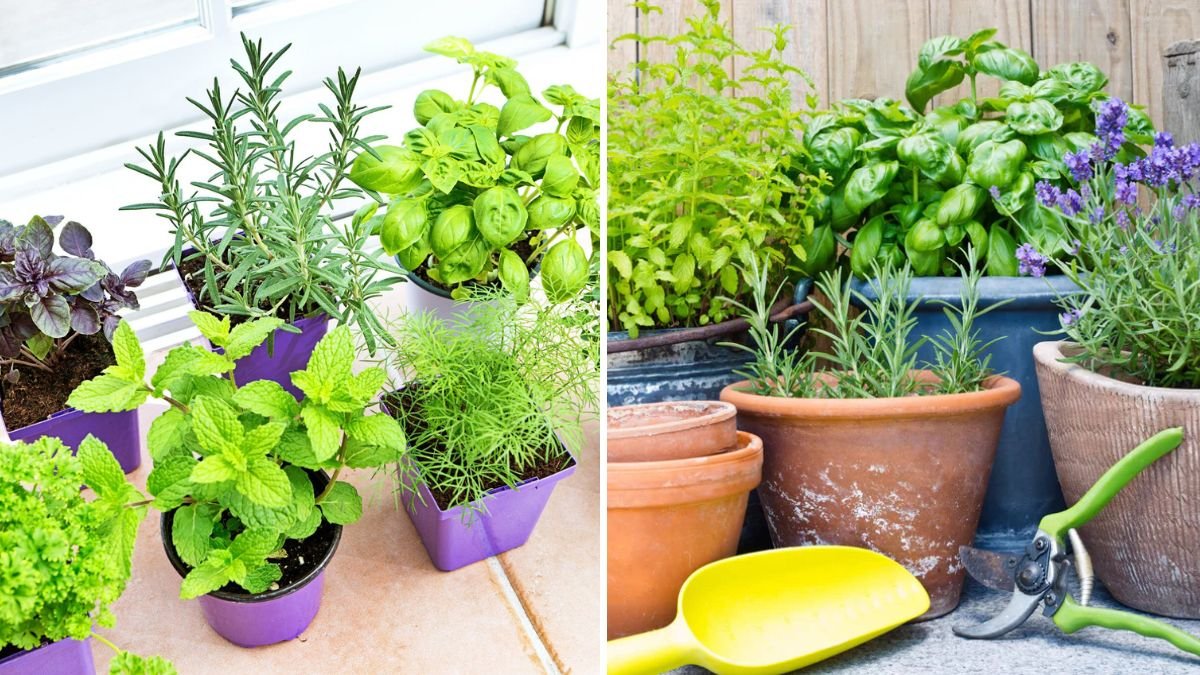Growing herbs in small containers is a practical and rewarding approach for gardeners with limited space. Whether you live in an apartment, have a balcony, or a compact kitchen, container-grown herbs provide fresh flavors, aromatic leaves, and continuous harvests year-round. With the right containers, soil, light, and care routines, herbs can thrive indoors and outdoors, supplying a steady stream of culinary and medicinal plants.
This article explores how to grow herbs in small containers throughout the year, detailing planting strategies, care techniques, seasonal adjustments, and tips to maximize flavor, growth, and sustainability.
1. Selecting the Right Herbs for Containers
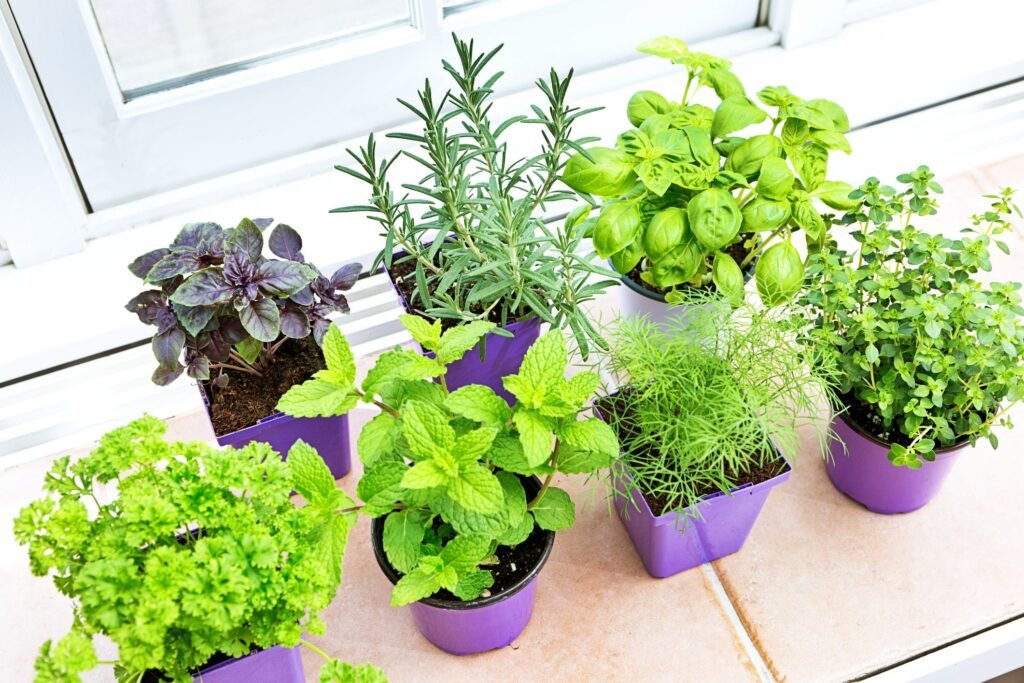
Not all herbs are suitable for small containers. Choosing the right varieties ensures healthy growth and continuous harvests:
- Compact and slow-growing herbs: Parsley, thyme, chives, oregano, and mint.
- Fast-growing annual herbs: Basil, cilantro, dill, and tarragon.
- Perennial herbs: Rosemary, sage, and lavender, which live for several years in containers.
When selecting herbs, consider growth habit, height, sunlight requirements, and culinary usage. Compact, bushy, or trailing herbs generally perform best in small containers.
2. Choosing the Right Containers
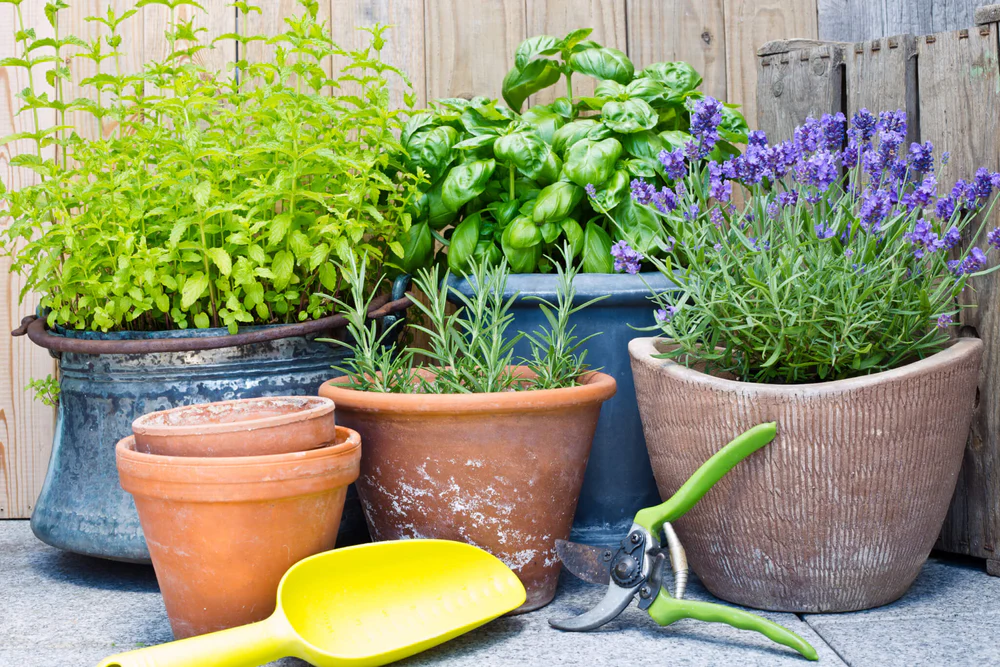
Container choice is critical for herb health:
- Size: Small containers (6–12 inches) work well for individual herbs.
- Material: Ceramic, terracotta, plastic, or metal; each has advantages:
- Terracotta: Breathable, prevents overwatering but dries out faster.
- Plastic: Lightweight, retains moisture longer, and easier to move indoors.
- Ceramic or metal: Stylish and durable but may need drainage management.
- Drainage: Ensure containers have drainage holes to prevent root rot.
- Shape: Wide and shallow for shallow-rooted herbs (like chives and thyme), deep for root-heavy herbs (like rosemary).
Proper container selection supports root development, prevents waterlogging, and allows year-round care.
3. Choosing and Preparing Soil
Herbs thrive in well-draining, nutrient-rich soil:
- Potting Mix: Use a lightweight potting mix instead of garden soil.
- Soil Additives: Add perlite or sand for drainage, and compost for nutrients.
- pH Requirements: Most herbs prefer slightly acidic to neutral soil (pH 6–7).
- Re-potting: Refresh soil annually or every two years to prevent nutrient depletion.
Healthy soil encourages strong root systems, better growth, and aromatic, flavorful leaves.
4. Lighting Requirements for Year-Round Growth
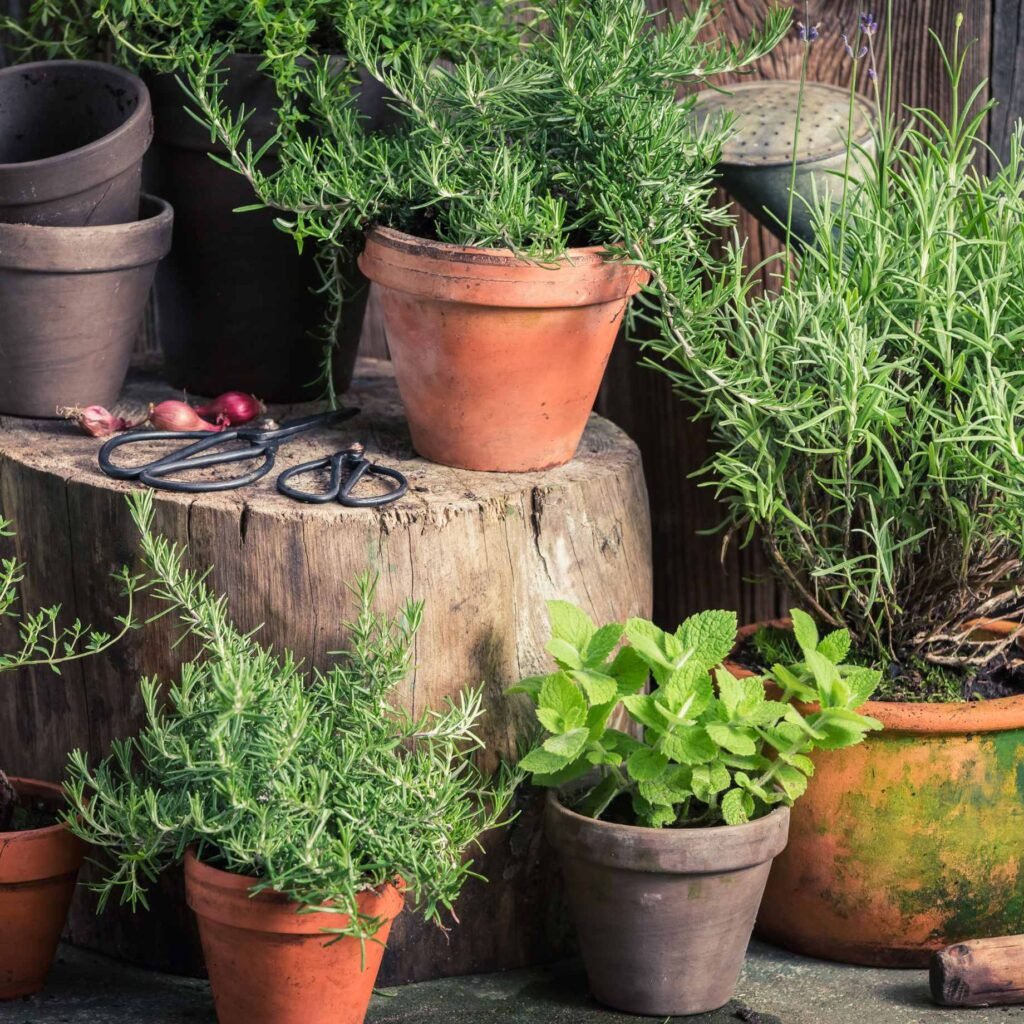
Light is one of the most critical factors for container herbs:
- Natural Sunlight: Herbs require 4–6 hours of sunlight daily. South- or west-facing windows are ideal indoors.
- Supplemental Lighting: Use LED grow lights for winter or low-light conditions. Position lights 6–12 inches above herbs for optimal growth.
- Rotation: Rotate containers periodically to ensure even light distribution and avoid leggy growth.
Sufficient light promotes photosynthesis, vibrant foliage, and robust growth year-round.
5. Watering Techniques for Container Herbs
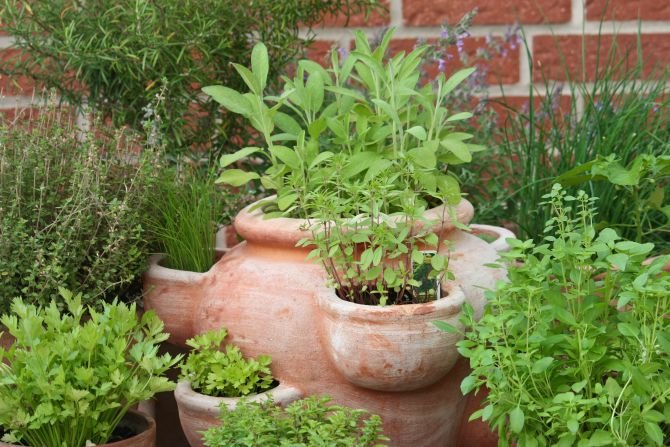
Proper watering prevents stress, diseases, and uneven growth:
- Consistency: Keep soil evenly moist but not soggy.
- Top-Down Watering: Water directly at the soil level, avoiding wetting leaves to reduce fungal risks.
- Seasonal Adjustments: Reduce watering in winter when growth slows, and increase during summer heat.
- Self-Watering Containers: Consider using self-watering pots to maintain consistent moisture levels.
Consistent watering ensures healthy roots and prevents herb loss in small containers.
6. Fertilizing for Continuous Growth
Nutrients are essential for herbs grown in small containers:
- Organic Fertilizers: Compost tea, worm castings, or liquid seaweed provide gentle nutrition.
- Balanced Fertilizers: Use low-dose NPK (Nitrogen-Phosphorus-Potassium) fertilizers every 4–6 weeks.
- Avoid Over-Fertilization: Excess nitrogen may cause leafy growth at the expense of flavor and aroma.
- Re-potting with Fresh Soil: Refreshing the soil annually replenishes nutrients naturally.
Fertilization supports vibrant, flavorful leaves and year-round productivity.
7. Seasonal Care Adjustments
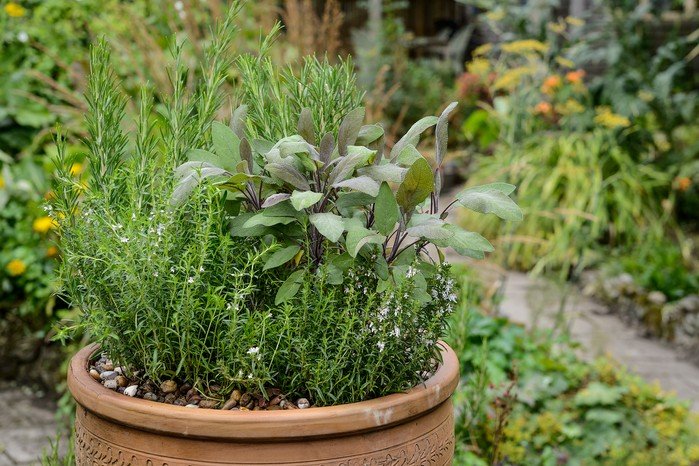
Herbs require adjustments depending on the season:
- Spring/Summer: Regular watering, full sunlight, and regular pruning encourage new growth.
- Autumn: Gradually reduce watering and remove dead or yellowing leaves. Move indoor-sensitive herbs to protected spaces.
- Winter: Place herbs near sunny windows or under grow lights. Reduce fertilization and water less frequently.
- Indoor Maintenance: Maintain room temperature above 15°C (59°F) for tropical herbs like basil.
Seasonal adjustments help maintain plant health and continuous harvests in small containers.
8. Pruning and Harvesting
Regular pruning is vital for small container herbs:
- Pruning: Remove old or yellowing leaves, pinch tips to encourage bushiness, and prevent legginess.
- Harvesting Frequency: Frequent harvesting encourages growth and prevents overgrowth.
- Proper Technique: Use clean scissors or pinch leaves with fingers; never remove more than one-third of the plant at a time.
- Flower Management: For culinary herbs like basil and oregano, remove flowers to prevent bitter taste and prolong leaf production.
Pruning ensures dense growth, flavor retention, and a visually appealing container garden.
9. Companion Planting in Small Containers
Growing multiple herbs together can maximize space and create mutually beneficial interactions:
- Compatible Combinations: Basil with parsley or chives with thyme. Avoid planting mint with others, as it spreads aggressively.
- Spacing: Maintain sufficient room for air circulation to prevent fungal diseases.
- Layering: Mix upright and trailing herbs in a single pot to create visual balance and functional growth.
Companion planting helps optimize space, enhance aesthetics, and improve plant health.
10. Pest and Disease Management
Even small container herbs can face pests and diseases:
- Common Pests: Aphids, spider mites, whiteflies, and fungus gnats.
- Prevention: Maintain clean containers, remove dead leaves, and ensure proper drainage.
- Organic Control: Neem oil, insecticidal soap, and companion planting repel pests naturally.
- Fungal Management: Avoid overwatering and provide adequate light and air circulation to prevent mildew.
Proactive pest and disease management ensures sustainable, year-round herb production.
11. Maximizing Flavor and Aromatic Qualities
Flavor is the ultimate goal in herb gardening:
- Sunlight: Full sun enhances essential oils, producing stronger aromas and flavors.
- Water Stress: Mildly reduced watering can intensify flavor but avoid plant stress.
- Fertilization: Avoid excessive nitrogen, which dilutes taste.
- Harvesting Timing: Harvest leaves in the morning when oils are most concentrated.
Following these techniques ensures fragrant, flavorful herbs all year long.
12. Creative Container Arrangements
Maximize both functionality and aesthetics with creative setups:
- Tiered Stands: Utilize vertical space for multiple small pots.
- Hanging Planters: Ideal for trailing herbs like thyme or oregano.
- Window Boxes: Perfect for kitchen access and sunlight.
- Groupings: Combine herbs of different colors, textures, and heights for visual interest.
Thoughtful arrangements enhance your balcony or indoor space while maintaining plant health.
Conclusion
Growing herbs in small containers all year is both practical and rewarding, offering fresh flavors, aromatic foliage, and decorative appeal in limited spaces. By selecting compact herb varieties, using appropriate containers, providing adequate light, and implementing proper watering, fertilization, pruning, and seasonal care, gardeners can enjoy continuous harvests throughout the year.
Companion planting, pest management, and creative container arrangements further enhance the health, productivity, and aesthetic value of your herb garden. With careful attention and regular maintenance, even the smallest balcony or kitchen corner can become a thriving, flavorful herb oasis, bringing greenery, nutrition, and sensory delight into daily life.
